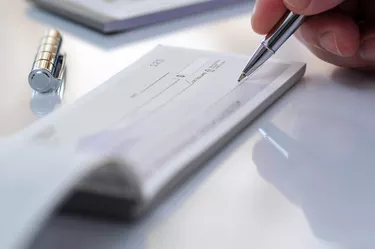
Banks often provide booklets of information that specify the benefits of opening a checking account. Although writing a check is one of the benefits, an explanation of a physical check is often overlooked.
Personal checks contain printed numbers at the bottom, printed in a font that allows bank computers to read them. It's important for account holders to understand these numbers because they show account information and can help identify fraudulent checks.
Video of the Day
Video of the Day
Read More: Check Routing Number Vs. Account Number
The Routing Number
The first nine numbers at the bottom of a personal check make up the routing number, also know as the routing transit number, American Bankers Association number, or ABA number. This number identifies the bank on which the check was drawn.
The routing number will always be nine digits, and it will vary from bank to bank and sometimes between bank branches. On both ends of the routing number, printed symbols that look like colons help bank computers recognize it as the routing number.
Read More: How to Cash a Check at a Check Cashing Store
The Account Number
The account number is to the right of the routing number. The number identifies the account on which the check was drawn. The number of digits can vary depending on the length of a bank's account numbers. This number terminates with a symbol similar to an apostrophe.
Read More: How to Find the Check Number on a Check
The Check Number
The four numbers to the right of the account number are the check number. This number should always match the check number printed in the top right corner of the check.
Ensuring that these numbers match is one way to catch check fraud. If the check number on the check's corner is less than four digits, the check number printed on the bottom of the check will have zeroes on the left to make up the missing digits.
Banks and account holders use check numbers to identify specific transactions. When you use e-checks, you might be asked to enter a check number. If so, tear up the paper check with this account number or you might accidentally use this check, which will bounce because it's already been used.
What Are MICR Numbers?
The numbers at the bottom of a check are printed in a magnetic ink character recognition, or MICR, font. The ink contains iron oxide and helps protect against fraud.
When bank machines pass a check through the reader, it first magnetizes the printed characters. When the check passes through the second time, the reader recognizes the magnetic waveform, similar to how a tape player's heads recognize music. Magnetic font is used instead of bar codes so that the numbers can be read and verified by human eyes.
A Little History
Although checks have been used for debt payment since ancient times, numeric identifiers were not added until the American Bankers Association developed a system of routing numbers in 1910. Routing numbers were designed to identify check processing endpoints as the banking system grew nationwide. Today, routing numbers are still used for their original purpose, but their role has expanded to allow for electronic checks and online bill payment.